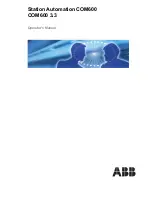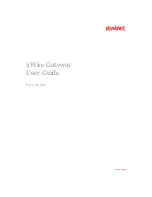
MediaGateway
User Manual
84
5.4
802.1AS in the MediaGateway
The MediaGateway allows the user to configure six different bridges through the
webpage. Each of them offers two possibilities: BridgeX_Master or BridgeX_Slave.
Each Broad-R Reach port can set as:
•
Disabled
: Port will not take part of any 802.1AS traffic.
•
BridgeX_Slave
: Only one per BridgeX. It will receive 801.2AS traffic from an
external master.
•
BridgeX_Master
: Port will send 802.1AS traffic coming from its BridgeX_Slave.
•
Master_802.1AS
: Port will work as 802.1AS Master Clock.
Warning
: Redirection of 802.1AS packets to processor are not following normal use of
VLANs. Please read the limitations.
5.5
Limitations in MediaGateway using 802.1AS
Given the need of working constantly with a high precision timestamping’s, and given
the huge number of packets pro 802.1AS OABR port that should be received and
transmitted by MediaGateway’s microcontroller, there are some limitations that the
user has to know in advance.
The implementation allows only the use of the 802.1AS in the 12 x OABR Ports of
the MediaGateway. Due to technical reasons, the use of the 802.1AS protocol is
not possible in Ethernet ports.
For a correct synchronization, all ports that form one Bridge (2 to 4 ports) should
be connected to the same Broadcom Ethernet Switch.
A Bridge should be formed by at least one port configured as Bridge_Slave
(Connected with 802.1AS Master) and up to 3 Ports configured as Bridge_Master
(Connected with 802.1AS Slave). It means the next possibilities pro Bridge are
allowed: 1BS:1BM, 1BS:2BM and 1BS:3BM.
For the use of the 802.1AS Bridge functionality of the MediaGateway, its
configuration should use double VLAN tagging with unidirectional VLAN IDs
Every port must have a unique
default VLAN ID
. Two ports are not allowed to have
the same
default VLAN ID
. This must be considered for the whole MediaGateway.
802.1AS should never be used with traffic injection.
This means: no injection of a third device into an 802.1AS Bridge
Announcement packages from best master clock (BMC) algorithm are not
corrected or forwarded (they should not be present in automotive networks as
there is only one master clock).
















































